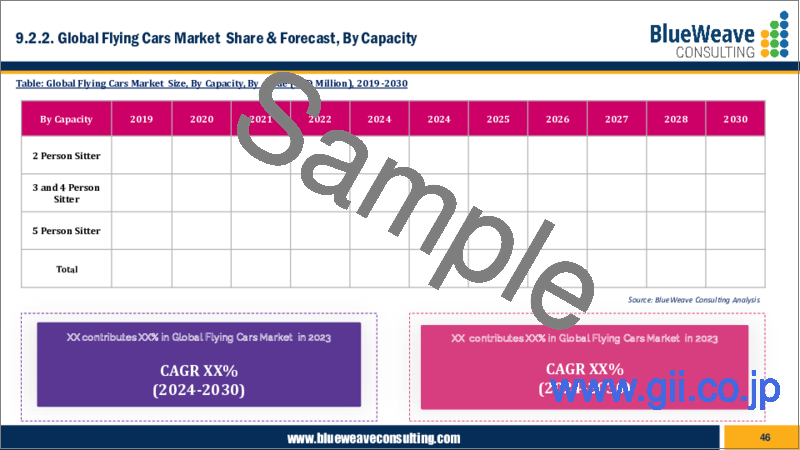|
|
市場調査レポート
商品コード
1466171
空飛ぶクルマ市場- 世界の市場規模、シェア、動向分析、機会、予測レポート、2019-2030年Flying Cars Market - Global Size, Share, Trend Analysis, Opportunity and Forecast Report, 2019-2030, Segmented By Product, By Capacity, By Application, By Region (North America, Europe, Asia Pacific, Latin America, Middle East and Africa ) |
||||||
|
|||||||
| 空飛ぶクルマ市場- 世界の市場規模、シェア、動向分析、機会、予測レポート、2019-2030年 |
|
出版日: 2024年04月05日
発行: Blueweave Consulting
ページ情報: 英文 235 Pages
納期: 2~3営業日
|
全表示
- 概要
- 目次
空飛ぶクルマの世界市場規模は2024~2030年にCAGR 15%で大幅に拡大し、2030年には39億米ドルに達する見込み
都市化の進展と 運転手と車両の安全性に対する懸念の高まりが、今後数年間の空飛ぶクルマ市場の活性化につながると予想されます。環境に優しい自動車に対する需要の高まりと都市人口の増加の両方の結果として、市場は今後数年間で上昇すると予想されます。さらに、購買力の増加とライフスタイルの進化が、予測期間中の市場成長を促進すると予想されます。
戦略コンサルティングと市場調査の大手企業であるBlueWeave Consulting社は、最近の調査で、2023年の空飛ぶクルマの世界市場規模を4億8,000万米ドルと推定しました。2024年から2030年にかけての予測期間中、BlueWeaveでは、空飛ぶクルマの世界市場規模がCAGR 15%で拡大し、2030年には39億米ドルに達すると予測しています。都市化の進展と 運転手と車両の安全性に対する懸念の高まりが、今後数年間の空飛ぶクルマ市場の活性化につながると予想されます。環境に優しい自動車に対する需要の高まりと都市人口の増加の両方の結果として、市場は今後数年間で上昇すると予想されます。加えて、購買力の増加とライフスタイルの進化が、予測期間中の市場成長を促進すると予想されます。特定の障壁や制限により市場が拡大しない可能性もあります。
機会:環境への配慮
多くの空飛ぶクルマの設計には電気推進システムが組み込まれており、従来の内燃エンジンと比べて温室効果ガスの排出を大幅に削減できる可能性があります。電気式空飛ぶクルマは飛行中に排出ガスをゼロにするため、大気汚染を緩和し、特に汚染レベルの高い都市部での二酸化炭素排出量を削減するのに役立ちます。空飛ぶクルマは、特に混雑した都市部において、地上の乗り物と比べてより効率的な輸送の可能性を提供します。交通渋滞を迂回し、直接飛行経路を利用することで、空飛ぶクルマは移動時間、エネルギー消費量、燃料使用量を削減し、全体的な排出量と環境負荷の低減につながります。空飛ぶクルマは、大気汚染、騒音公害、生息地破壊の主な原因となっている従来の道路走行車に代わる交通手段を提供します。移動需要の一部を道路から空へとシフトさせることで、空飛ぶクルマは道路インフラへの負担を軽減し、交通渋滞を緩和し、都市環境の大気質を改善することができます。都市の大気汚染は世界的に懸念が高まっており、自動車の排気ガスが大気汚染の大きな原因となっています。空飛ぶクルマは、汚染レベルが通常より低い都市上空で運行する代替交通手段を提供することで、地上レベルの排出量を削減する可能性を秘めています。電気推進、軽量素材、再生可能エネルギー源など、環境に優しい技術の採用が、空飛ぶクルマ業界の技術革新を促進しています。メーカー各社は、設計において持続可能性と環境性能を優先する傾向を強めており、環境意識の高い消費者や投資家を空飛ぶクルマ市場に引き付けています。
地政学的緊張が空飛ぶクルマの世界市場に与える影響
地政学的緊張の高まりにより、自動運転車などの最先端技術に対する規制や制限が厳しくなる可能性があります。各国政府は、革新的な輸送技術の創出や応用よりも国家安全保障問題を優先する可能性があり、その結果、法律や輸出規制が強化されたり、国境を越えた協力が制限されたりする可能性があります。これは空飛ぶクルマ産業の発展を妨げ、プロジェクトの進展を遅らせる可能性があります。地政学的緊張によって世界・サプライ・チェーンが混乱し、空飛ぶクルマの生産に必要な重要部品や材料の入手に影響が及ぶ可能性があります。空飛ぶクルマの開発・製造は、貿易紛争、制裁措置、地政学的危機による供給の途絶によって影響を受ける可能性があります。こうした混乱には、電気推進システム、自律航行システム、軽量素材などが含まれます。
空飛ぶクルマの世界市場
セグメント別情報
空飛ぶクルマの世界市場:製品別
製品別に見ると、有人空飛ぶクルマの市場は、業界の技術革新に拍車をかけ、空飛ぶクルマの試作の性能、安全性、効率を高める技術的進歩の結果、予測期間中に拡大すると予測されます。投資家、ベンチャーキャピタル、政府機関の増加が、人間主導の空飛ぶ乗り物の開発を推進しています。研究開発、起業資金、インフラ構想への投資の増加により、この分野はより迅速に前進しています。これにより、空飛ぶクルマメーカーに新たな市場が開かれつつあります。
競合情勢
世界の空飛ぶクルマ市場は細分化されており、数多くのプレーヤーが市場に参入しています。世界の空飛ぶクルマ市場を独占している主なプレーヤーは、Klein Vision、Volocopter GmbH、Airbus S.A.S.、Lilium、AeroMobil、PAL-V Liberty、現代自動車、Terrafugia、The Boeing Companyなどです。各プレイヤーが採用する主なマーケティング戦略は、顧客リーチを拡大し、市場全体における競争力を獲得するための施設拡張、製品の多様化、提携、協力、パートナーシップ、買収です。
本レポートの詳細な分析により、成長の可能性、今後の動向、世界の空飛ぶ車市場の統計に関する情報を提供します。また、総市場規模の予測を促進する要因も取り上げています。当レポートは、世界の空飛ぶクルマ市場における最近の技術動向を業界考察とともに提供し、意思決定者が健全な戦略的意思決定を行えるよう支援することをお約束します。さらに、市場の成長促進要因・課題・競争力についても分析しています。
目次
第1章 調査の枠組み
第2章 エグゼクティブサマリー
第3章 世界の空飛ぶクルマ市場の洞察
- 業界バリューチェーン分析
- DROC分析
- 成長促進要因
- 交通渋滞の拡大
- 都市化の進行
- 技術の進歩
- 政府の投資
- 抑制要因
- 安全性に関する懸念
- 高コスト製品
- 機会
- 環境への懸念
- 航空輸送の需要の高まり
- 課題
- 国民の受容
- 安全性
- 成長促進要因
- 技術の進歩/最近の開発
- 規制の枠組み
- ポーターのファイブフォース分析
第4章 世界の空飛ぶ車市場:マーケティング戦略
第5章 世界の空飛ぶ車市場:価格分析
第6章 世界の空飛ぶ車市場:地域分析
- 世界の空飛ぶ車市場、地域分析、2023年
- 世界の空飛ぶ車市場、市場魅力度分析、2024-2030年
第7章 世界の空飛ぶクルマ市場概要
- 市場規模と予測、2019-2030年
- 金額別
- 市場シェアと予測
- 製品別
- 有人空飛ぶ車
- 無人空飛ぶ車
- 容量別
- 2人乗り
- 3人または4人乗り
- 5人乗り
- アプリケーション別
- 軍事
- 商用
- 民間
- 地域別
- 北米
- 欧州
- アジア太平洋(APAC)
- ラテンアメリカ(LATAM)
- 中東およびアフリカ(MEA)
- 製品別
第8章 北米飛ぶクルマ市場
- 市場規模と予測、2019-2030年
- 金額別
- 市場シェアと予測
- 製品別
- 容量別
- アプリケーション別
- 国別
- 米国
- カナダ
第9章 欧州の空飛ぶ自動車市場
- 市場規模と予測、2019-2030年
- 金額別
- 市場シェアと予測
- 製品別
- 容量別
- アプリケーション別
- 国別
- ドイツ
- 英国
- イタリア
- フランス
- スペイン
- ベルギー
- ロシア
- オランダ
- その他
第10章 アジア太平洋地域の空飛ぶクルマ市場
- 市場規模と予測、2019-2030年
- 金額別
- 市場シェアと予測
- 製品別
- 容量別
- アプリケーション別
- 国別
- 中国
- インド
- 日本
- 韓国
- オーストラリアとニュージーランド
- インドネシア
- マレーシア
- シンガポール
- ベトナム
- その他
第11章 ラテンアメリカの空飛ぶ自動車市場
- 市場規模と予測、2019-2030年
- 金額別
- 市場シェアと予測
- 製品別
- 容量別
- アプリケーション別
- 国別
- ブラジル
- メキシコ
- アルゼンチン
- ペルー
- その他
第12章 中東およびアフリカの空飛ぶ自動車市場
- 市場規模と予測、2019-2030年
- 金額別
- 市場シェアと予測
- 製品別
- 容量別
- アプリケーション別
- 国別
- サウジアラビア
- アラブ首長国連邦
- カタール
- クウェート
- 南アフリカ
- ナイジェリア
- アルジェリア
- その他
第13章 競合情勢
- 主要プレーヤーとその提供内容のリスト
- 世界の空飛ぶ自動車企業の市場シェア分析、2023年
- 経営パラメータによる競合ベンチマーキング
- 主要な戦略的展開(合併、買収、提携など)
第14章 地政学的緊張の高まりが世界の空飛ぶ車市場に与える影響
第15章 企業プロファイル(会社概要、財務マトリックス、競合情勢、主要人物、主要競合、連絡先、戦略展望、 SWOT分析)
- Klein Vision
- Volocopter GmbH
- Airbus SAS
- Lilium
- AeroMobil
- PAL-V Liberty
- Hyundai Motor Company
- Terrafugia
- The Boeing Company
- その他の主要企業
第16章 主要な戦略的提言
第17章 調査手法
Global Flying Cars Market Size Set Expands at Significant CAGR of 15% During 2024-2030 to Reach USD 3,900 Million by 2030
Rising urbanization and growing worries about driver and vehicle safety are expected to fuel the flying vehicles market over the next years. The market is expected to rise in the next years as a result of both the rising demand for environmentally friendly automobiles and the growing urban population. In addition, it is anticipated that growing purchasing power and evolving lifestyles would drive market growth over the forecast period.
BlueWeave Consulting, a leading strategic consulting and market research firm, in its recent study, estimated the Global Flying Cars Market size at USD 480 Million in 2023. During the forecast period between 2024 and 2030, BlueWeave expects the Global Flying Cars Market size to expand at a CAGR of 15% reaching a value of USD 3,900 Million by 2030. Rising urbanisation and growing worries about driver and vehicle safety are expected to fuel the flying vehicles market over the next years. The market is expected to rise in the next years as a result of both the rising demand for environmentally friendly automobiles and the growing urban population. In addition, it is anticipated that growing purchasing power and evolving lifestyles would drive market growth over the forecast period. The market may not be able to expand due to certain barriers and restrictions.
Opportunity: Environmental concerns
Many flying car designs incorporate electric propulsion systems, which have the potential to significantly reduce greenhouse gas emissions compared to traditional internal combustion engines. Electric flying cars produce zero emissions during flight, helping to mitigate air pollution and reduce carbon footprint, especially in urban areas where pollution levels are high. Flying cars offer the potential for more efficient transportation compared to ground vehicles, particularly in congested urban areas. By bypassing traffic congestion and utilizing direct flight paths, flying cars can reduce travel times, energy consumption, and fuel usage, leading to lower overall emissions and environmental impact. Flying cars provide an alternative mode of transportation to traditional road vehicles, which are major contributors to air pollution, noise pollution, and habitat destruction. By shifting some travel demand from roads to the air, flying cars can help alleviate pressure on road infrastructure, reduce traffic congestion, and improve air quality in urban environments. Urban air quality is a growing concern worldwide, with vehicular emissions being a significant contributor to air pollution in cities. Flying cars have the potential to reduce ground-level emissions by offering an alternative mode of transportation that operates in the airspace above cities, where pollution levels are typically lower. The adoption of green technologies, including electric propulsion, lightweight materials, and renewable energy sources, is driving innovation in the flying car industry. Manufacturers are increasingly prioritizing sustainability and environmental performance in their designs, attracting environmentally conscious consumers and investors to the market.
Impact of Geopolitical Tensions on Global Flying Cars Market
Enhanced geopolitical tensions could result in more stringent regulations and limitations on cutting-edge technologies such as self-driving automobiles. Governments may place a higher priority on national security issues than on the creation and application of innovative transportation technology, which could lead to tighter laws, export controls, or restrictions on cross-border cooperation. This can hinder the development of the flying car industry and slow down project advancement. Global supply chains can be disrupted by geopolitical tensions, which can have an impact on the availability of vital parts and materials needed to produce flying cars. The development and manufacture of flying cars may be impacted by supply disruptions caused by trade disputes, sanctions, or geopolitical crises. Examples of these disruptions include electric propulsion systems, autonomous navigation systems, or lightweight materials.
Global Flying Cars Market
Segmental Information
Global Flying Cars Market - By Product
Based on product, the market for manned flying cars is anticipated to expand during the forecast period as a result of technical advancements that are spurring industry innovation and enhancing the performance, safety, and efficiency of flying vehicle prototypes. An increasing number of investors, venture capitalists, and government organizations are driving the development of human-driven aerial vehicles. The sector is moving forward more quickly thanks to increased investment in R&D, startup capital, and infrastructure initiatives. This is opening up new markets for makers of flying cars.
Competitive Landscape
The global flying cars market is fragmented, with numerous players serving the market. The key players dominating the global flying cars market include Klein Vision, Volocopter GmbH, Airbus S.A.S., Lilium, AeroMobil , PAL-V Liberty, Hyundai Motor Company, Terrafugia , The Boeing Company. The key marketing strategies adopted by the players are facility expansion, product diversification, alliances, collaborations, partnerships, and acquisitions to expand their customer reach and gain a competitive edge in the overall market.
The report's in-depth analysis provides information about growth potential, upcoming trends, and the global flying cars market statistics. It also highlights the factors driving forecasts of total market size. The report promises to provide recent technology trends in the global flying cars market along with industry insights to help decision-makers make sound strategic decisions. Furthermore, the report also analyses the growth drivers, challenges, and competitive dynamics of the market.
Table of Contents
1. Research Framework
- 1.1. Research Objective
- 1.2. Product Overview
- 1.3. Market Segmentation
2. Executive Summary
3. Global Flying Cars Market Insights
- 3.1. Industry Value Chain Analysis
- 3.2. DROC Analysis
- 3.2.1. Growth Drivers
- 3.2.1.1. Growing traffic congestion
- 3.2.1.2. Increasing urbanization
- 3.2.1.3. Technological advancements
- 3.2.1.4. Government investment
- 3.2.2. Restraints
- 3.2.2.1. Safety concern
- 3.2.2.2. High cost product
- 3.2.3. Opportunities
- 3.2.3.1. Environmental concerns
- 3.2.3.2. Rising demand for air mobility
- 3.2.4. Challenges
- 3.2.4.1. Public acceptance
- 3.2.4.2. Security
- 3.2.1. Growth Drivers
- 3.3. Technology Advancements/Recent Developments
- 3.4. Regulatory Framework
- 3.5. Porter's Five Forces Analysis
- 3.5.1. Bargaining Power of Suppliers
- 3.5.2. Bargaining Power of Buyers
- 3.5.3. Threat of New Entrants
- 3.5.4. Threat of Substitutes
- 3.5.5. Intensity of Rivalry
4. Global Flying Cars Market: Marketing Strategies
5. Global Flying Cars Market: Pricing Analysis
6. Global Flying Cars Market: Geographical Analysis
- 6.1. Global Flying Cars Market, Geographical Analysis, 2023
- 6.2. Global Flying Cars Market, Market Attractiveness Analysis, 2024-2030
7. Global Flying Cars Market Overview
- 7.1. Market Size & Forecast, 2019-2030
- 7.1.1. By Value (USD Million)
- 7.2. Market Share & Forecast
- 7.2.1. By Product
- 7.2.1.1. Manned Flying Cars
- 7.2.1.2. Unmanned Flying Cars
- 7.2.2. By Capacity
- 7.2.2.1. 2 Person Sitter
- 7.2.2.2. 3 and 4 Person Sitter
- 7.2.2.3. 5 Person Sitter
- 7.2.3. By Application
- 7.2.3.1. Military
- 7.2.3.2. Commercial
- 7.2.3.3. Civil
- 7.2.4. By Region
- 7.2.4.1. North America
- 7.2.4.2. Europe
- 7.2.4.3. Asia Pacific (APAC)
- 7.2.4.4. Latin America (LATAM)
- 7.2.4.5. Middle East and Africa (MEA)
- 7.2.1. By Product
8. North America Flying Cars Market
- 8.1. Market Size & Forecast, 2019-2030
- 8.1.1. By Value (USD Million)
- 8.2. Market Share & Forecast
- 8.2.1. By Product
- 8.2.2. By Capacity
- 8.2.3. By Application
- 8.2.4. By Country
- 8.2.4.1. United States
- 8.2.4.1.1. By Product
- 8.2.4.1.2. By Capacity
- 8.2.4.1.3. By Application
- 8.2.4.2. Canada
- 8.2.4.2.1. By Product
- 8.2.4.2.2. By Capacity
- 8.2.4.2.3. By Application
9. Europe Flying Cars Market
- 9.1. Market Size & Forecast, 2019-2030
- 9.1.1. By Value (USD Million)
- 9.2. Market Share & Forecast
- 9.2.1. By Product
- 9.2.2. By Capacity
- 9.2.3. By Application
- 9.2.4. By Country
- 9.2.4.1. Germany
- 9.2.4.1.1. By Product
- 9.2.4.1.2. By Capacity
- 9.2.4.1.3. By Application
- 9.2.4.2. United Kingdom
- 9.2.4.2.1. By Product
- 9.2.4.2.2. By Capacity
- 9.2.4.2.3. By Application
- 9.2.4.3. Italy
- 9.2.4.3.1. By Product
- 9.2.4.3.2. By Capacity
- 9.2.4.3.3. By Application
- 9.2.4.4. France
- 9.2.4.4.1. By Product
- 9.2.4.4.2. By Capacity
- 9.2.4.4.3. By Application
- 9.2.4.5. Spain
- 9.2.4.5.1. By Product
- 9.2.4.5.2. By Capacity
- 9.2.4.5.3. By Application
- 9.2.4.6. Belgium
- 9.2.4.6.1. By Product
- 9.2.4.6.2. By Capacity
- 9.2.4.6.3. By Application
- 9.2.4.7. Russia
- 9.2.4.7.1. By Product
- 9.2.4.7.2. By Capacity
- 9.2.4.7.3. By Application
- 9.2.4.8. The Netherlands
- 9.2.4.8.1. By Product
- 9.2.4.8.2. By Capacity
- 9.2.4.8.3. By Application
- 9.2.4.9. Rest of Europe
- 9.2.4.9.1. By Product
- 9.2.4.9.2. By Capacity
- 9.2.4.9.3. By Application
10. Asia Pacific Flying Cars Market
- 10.1. Market Size & Forecast, 2019-2030
- 10.1.1. By Value (USD Million)
- 10.2. Market Share & Forecast
- 10.2.1. By Product
- 10.2.2. By Capacity
- 10.2.3. By Application
- 10.2.4. By Country
- 10.2.4.1. China
- 10.2.4.1.1. By Product
- 10.2.4.1.2. By Capacity
- 10.2.4.1.3. By Application
- 10.2.4.2. India
- 10.2.4.2.1. By Product
- 10.2.4.2.2. By Capacity
- 10.2.4.2.3. By Application
- 10.2.4.3. Japan
- 10.2.4.3.1. By Product
- 10.2.4.3.2. By Capacity
- 10.2.4.3.3. By Application
- 10.2.4.4. South Korea
- 10.2.4.4.1. By Product
- 10.2.4.4.2. By Capacity
- 10.2.4.4.3. By Application
- 10.2.4.5. Australia & New Zealand
- 10.2.4.5.1. By Product
- 10.2.4.5.2. By Capacity
- 10.2.4.5.3. By Application
- 10.2.4.6. Indonesia
- 10.2.4.6.1. By Product
- 10.2.4.6.2. By Capacity
- 10.2.4.6.3. By Application
- 10.2.4.7. Malaysia
- 10.2.4.7.1. By Product
- 10.2.4.7.2. By Capacity
- 10.2.4.7.3. By Application
- 10.2.4.8. Singapore
- 10.2.4.8.1. By Product
- 10.2.4.8.2. By Capacity
- 10.2.4.8.3. By Application
- 10.2.4.9. Vietnam
- 10.2.4.9.1. By Product
- 10.2.4.9.2. By Capacity
- 10.2.4.9.3. By Application
- 10.2.4.10. Rest of APAC
- 10.2.4.10.1. By Product
- 10.2.4.10.2. By Capacity
- 10.2.4.10.3. By Application
11. Latin America Flying Cars Market
- 11.1. Market Size & Forecast, 2019-2030
- 11.1.1. By Value (USD Million)
- 11.2. Market Share & Forecast
- 11.2.1. By Product
- 11.2.2. By Capacity
- 11.2.3. By Application
- 11.2.4. By Country
- 11.2.4.1. Brazil
- 11.2.4.1.1. By Product
- 11.2.4.1.2. By Capacity
- 11.2.4.1.3. By Application
- 11.2.4.2. Mexico
- 11.2.4.2.1. By Product
- 11.2.4.2.2. By Capacity
- 11.2.4.2.3. By Application
- 11.2.4.3. Argentina
- 11.2.4.3.1. By Product
- 11.2.4.3.2. By Capacity
- 11.2.4.3.3. By Application
- 11.2.4.4. Peru
- 11.2.4.4.1. By Product
- 11.2.4.4.2. By Capacity
- 11.2.4.4.3. By Application
- 11.2.4.5. Rest of LATAM
- 11.2.4.5.1. By Product
- 11.2.4.5.2. By Capacity
- 11.2.4.5.3. By Application
12. Middle East & Africa Flying Cars Market
- 12.1. Market Size & Forecast, 2019-2030
- 12.1.1. By Value (USD Million)
- 12.2. Market Share & Forecast
- 12.2.1. By Product
- 12.2.2. By Capacity
- 12.2.3. By Application
- 12.2.4. By Country
- 12.2.4.1. Saudi Arabia
- 12.2.4.1.1. By Product
- 12.2.4.1.2. By Capacity
- 12.2.4.1.3. By Application
- 12.2.4.2. UAE
- 12.2.4.2.1. By Product
- 12.2.4.2.2. By Capacity
- 12.2.4.2.3. By Application
- 12.2.4.3. Qatar
- 12.2.4.3.1. By Product
- 12.2.4.3.2. By Capacity
- 12.2.4.3.3. By Application
- 12.2.4.4. Kuwait
- 12.2.4.4.1. By Product
- 12.2.4.4.2. By Capacity
- 12.2.4.4.3. By Application
- 12.2.4.5. South Africa
- 12.2.4.5.1. By Product
- 12.2.4.5.2. By Capacity
- 12.2.4.5.3. By Application
- 12.2.4.6. Nigeria
- 12.2.4.6.1. By Product
- 12.2.4.6.2. By Capacity
- 12.2.4.6.3. By Application
- 12.2.4.7. Algeria
- 12.2.4.7.1. By Product
- 12.2.4.7.2. By Capacity
- 12.2.4.7.3. By Application
- 12.2.4.8. Rest of MEA
- 12.2.4.8.1. By Product
- 12.2.4.8.2. By Capacity
- 12.2.4.8.3. By Application
13. Competitive Landscape
- 13.1. List of Key Players and Their Offerings
- 13.2. Global Flying Cars Company Market Share Analysis, 2023
- 13.3. Competitive Benchmarking, By Operating Parameters
- 13.4. Key Strategic Developments (Mergers, Acquisitions, Partnerships, etc.)
14. Impact of Escalating Geopolitical Tension on Global Flying Cars Market
15. Company Profile (Company Overview, Financial Matrix, Competitive Landscape, Key Personnel, Key Competitors, Contact Address, Strategic Outlook, SWOT Analysis)
- 15.1. Klein Vision
- 15.2. Volocopter GmbH
- 15.3. Airbus S.A.S.
- 15.4. Lilium
- 15.5. AeroMobil
- 15.6. PAL-V Liberty
- 15.7. Hyundai Motor Company
- 15.8. Terrafugia
- 15.9. The Boeing Company
- 15.10. Other Prominent Players
16. Key Strategic Recommendations
17. Research Methodology
- 17.1. Qualitative Research
- 17.1.1. Primary & Secondary Research
- 17.2. Quantitative Research
- 17.3. Market Breakdown & Data Triangulation
- 17.3.1. Secondary Research
- 17.3.2. Primary Research
- 17.4. Breakdown of Primary Research Respondents, By Region
- 17.5. Assumptions & Limitations





